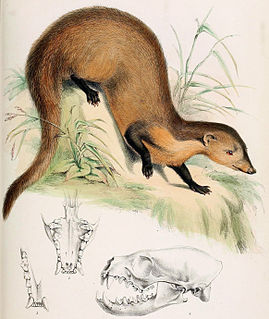
Zaptié was the designation given to locally raised gendarmerie units in the Italian colonies of Tripolitania, Cyrenaica, Eritrea and Somaliland between 1889 and 1943.

The collared mongoose is a species of mongoose in the family Herpestidae. It is found in Brunei, Indonesia, and Malaysia.
Chrysocale is a genus of moths in the subfamily Arctiinae.
Nocardicin A is a β-lactam antibiotic included in the monobactam subclass. It is secreted by the bacterium Nocardia uniformis subsp. tsuyamenensis as a metabolic product catalyzed by the enzyme nocardicin-A epimerase.
Chrysocale betzi is a moth of the subfamily Arctiinae. It was described by Viette in 1980. It is found in Ecuador.
Chrysocale corax is a moth of the subfamily Arctiinae. It was described by George Hampson in 1901. It is found in Peru.
Chrysocale ferens is a moth of the subfamily Arctiinae. It was described by Schaus in 1896. It is found in Bolivia and Peru.
Chrysocale fletcheri is a moth of the subfamily Arctiinae. It was described by Viette in 1980. It is found in Peru.
Chrysocale gigas is a moth of the subfamily Arctiinae. It was described by Rothschild in 1911. It is found in Colombia, Ecuador and Peru.
Chrysocale ignita is a moth of the subfamily Arctiinae. It was described by Gottlieb August Wilhelm Herrich-Schäffer in 1853. It is found in Colombia.
Chrysocale pava is a moth in the subfamily Arctiinae. It was described by Paul Dognin in 1893. It is found in Venezuela.
Chrysocale plebeja is a moth of the subfamily Arctiinae. It was described by Gottlieb August Wilhelm Herrich-Schäffer in 1853. It is found in Venezuela.
Chrysocale principalis, the princely tiger moth, is a moth of the subfamily Arctiinae. It was described by Francis Walker in 1864. It is found in Mexico and Guatemala.
Chrysocale regalis is a moth of the subfamily Arctiinae. It was described by Jean Baptiste Boisduval in 1836. It is found in Ecuador and Bolivia.
Chrysocale splendens is a moth of the subfamily Arctiinae. It was described by Paul Dognin in 1888. It is found in Ecuador.
The Euchromiina are a subtribe of tiger moths in the family Erebidae. Many species in the subtribe are mimics of wasps.
Stenoglene uniformis is a moth in the family Eupterotidae. It was described by Ugo Dall'Asta and G. Poncin in 1980. It is found in the former Orientale Province of the Democratic Republic of the Congo and in the Central African Republic.
Schistissa is a monotypic moth genus in the family Eupterotidae. Its single species, Schistissa uniformis, is found in South Africa. Both the genus and species were described by Per Olof Christopher Aurivillius in 1901.
Macrosoma uniformis is a moth-like butterfly in the family Hedylidae. It was described by William Warren in 1904.
The Military ranks of the Italian Social Republic were the military insignia used by the Italian Armed Forces of the Italian Social Republic. The ranks were essentially the same as the Military ranks of the Kingdom of Italy, however, with the symbols of the monarchy removed.



